While you are staying at the Inn, wouldn’t it be fun to explore the beautiful state of Kansas? We invite you to use the Inn as your home base and venture out to one of these interesting Kansas treasures. Many of the day trips will take you to destinations that have been awarded the distinguished honor as one of the “8 Wonders of Kansas” by the Kansas Sampler Foundation. The descriptions and photos are credited to their website at www.kansassampler.org. All the trips are under 2 1/2 hours way and cater to a variety of interests. Take a look and plan your next adventure today!
Download Drom Sott Inn Day Trips
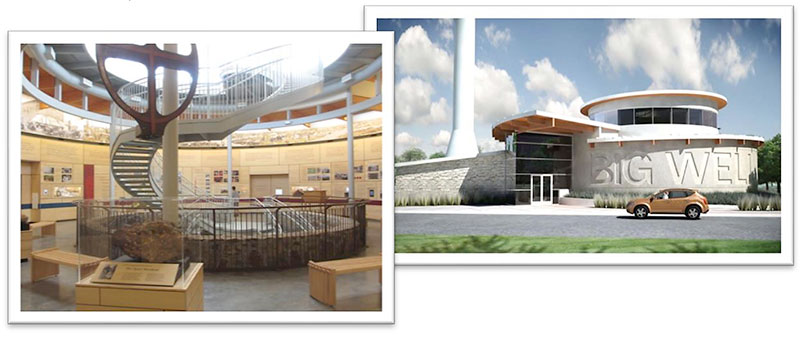
Big Well
(one of the 8 Wonders of Kansas)
315 S. Sycamore, Greensburg, KS 67504
(2 hours 13 minutes southwest of Inn)
620.723.4102
www.bigwell.org
Hours:
Monday – Saturday, 9:00 am – 6:00 pm
Sunday 1:00 pm – 6:00 pm
The Big Well is one of The 8 Wonders of Kansas because the construction of it was an engineering marvel in its day and it is the world’s largest hand-dug well! On August 9, 1887 Jack Wheeler led his crew in an architectural adventure as the first shovel dug into what would become a 32-feet wide, 109-feet deep well with two feet thick native stone walls. Taking almost two years, the well was hand-dug, cribbed, cased and stoned with rock from the Medicine River and sand from the Cowskin Creek. Stone masons of Herculean talent constructed what many have called “a pioneer engineering marvel.” Although the well was built for city water it was also built alongside the Kingman, Pratt, & Western rail line, a subsidiary of the Santa Fe, which ran a freight line from Wichita to the Mullinville turnaround until 1893. A large amount of water was needed for the steam locomotives.
The Big Well supplied Greensburg with water until 1932 when another well was dug nearby. In 1939 the folks of Greensburg decided to slap a handmade sign along the highway and began sporting their wonder as a Kansas tourism site. Hundreds of thousands of people have visited the Big Well from every state and from all over the world since then. Obviously, the Big Well had become the economic heartbeat of Greensburg. On May 7, 2007, Greensburg was hit by a monster EF5 tornado that destroyed much of the town, including everything above ground at the Big Well. A new museum at the Big Well opened May 26, 2012. (from KansasSampler.org)
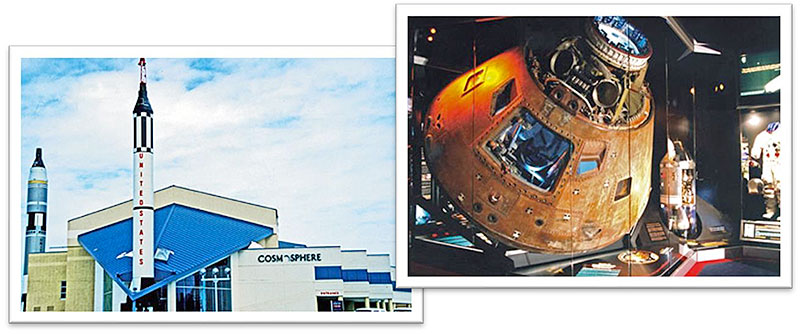 Kansas Cosmosphere
Kansas Cosmosphere
(one of the 8 Wonders of Kansas)
1110 North Plum Street, Hutchinson, KS 67501
(47 minutes north of Inn)
620.662.2305
www.cosmo.org
Hours:
Monday – Saturday, 9:00 am – 7:00 pm
Sunday, Noon – 7:00 pm
The Cosmosphere is one of The 8 Wonders of Kansas because it has one of the most significant collections of U.S. and Russian space artifacts in the world! The Cosmosphere, conceived by long-time Hutchinson resident Patricia Carey, is one of America’s premier space centers. Making its start as a small planetarium on the Kansas State Fairgrounds, the Cosmosphere is now an internationally acclaimed staple of the space science community. Educating patrons from around the globe, the Cosmosphere boasts the Hall of Space museum, one of the most significant collections of U.S. and Russian space artifacts in the world; the Carey IMAX Dome Theater, one of only 14 IMAXR dome theaters in the world; a planetarium; and astronaut training camps for all ages. Located in central Hutchinson, the Cosmosphere, a non-profit organization, is unique to Kansas. Its Hall of Space Museum is one of only three museums in the world to display flown spacecraft from all three early-manned space programs – Mercury (Liberty Bell 7), Gemini (Gemini 10) and Apollo (Apollo 13). Regarding depth and size, the Cosmosphere’s space artifact collection is second only to that of the National Air and Space Museum in Washington, D.C. Similarly, the Cosmosphere’s Hall of Space Museum harbors the largest collection of Russian space artifacts outside Moscow. Proudly placed in Kansas, the Cosmosphere has also taken part in many documentaries and films. Most notably, the Cosmosphere built the spacecraft and hardware used in the movie Apollo 13, starring Tom Hanks. (from Kansas Sampler.org)
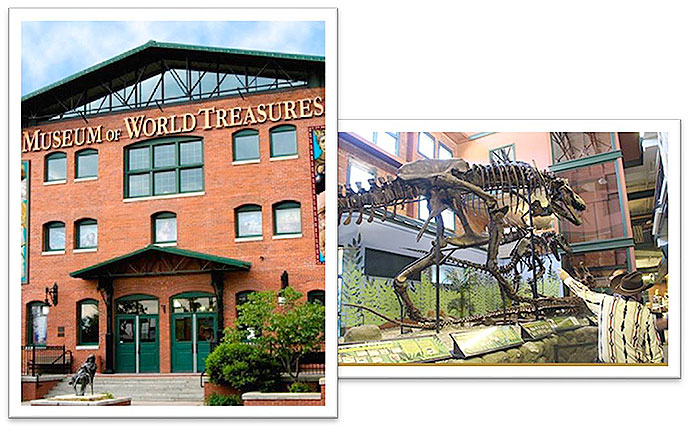 Museum of World Treasures
Museum of World Treasures
835 East 1st Street, Wichita, KS 67202
(1 hour 6 minutes south of the Inn)
316.263.1311
www.worldtreasures.org
Hours:
Monday – Saturday, 10:00 am – 5:00 pm
Sunday, 12 Noon – 5:00 pm
Experience a trek through time at the Museum of World Treasures. History comes alive as you delve into the lives of dinosaurs, Ancient Egyptians, past presidents, and so much more. From shrunken heads to an extensive World War II collection, there are incredible stories around every corner of the Museum. Bring the whole family for an adventure that will educate, entertain, and hopefully ignite a love for lifelong learning. Current Exhibits:
| FOSSIL GALLERY | SEA CREATURES OF THE PLAINS | CENOZOIC ERA |
| ROCKS & MINERALS | CIVIL WAR | WORLD WAR I |
| WORLD WAR II | VIET NAM WAR | KOREAN WAR |
| BERLIN WALL | FOUNDING OF AMERICA | HALL OF PRESIDENTS |
| OLD WEST | MESOPOTAMIA | ANCIENT EGYPT |
| ANCIENT GREECE | ANCIENT ROME | PRE-HISPANIC |
| AFRICA | ROYAL ART OF ASIA | ALL ARE NOT FREE: EXPERIENCES OF BERLIN RESIDENTS DURING THE COLD WAR |
 Tallgrass Prairie National Preserve & the Flint Hills, Chase County
Tallgrass Prairie National Preserve & the Flint Hills, Chase County
(one of the 8 Wonders of Kansas)
2480 K-177, Strong City, KS 66869
(1 hour 20 minutes east of the Inn)
Phone: 620.273.8494
www.nps.gov/tapr/
Hours:
May-October 8:30a.m.- 4:30p.m.; Winter hours 9 a.m.-4:30 p.m.
The Tallgrass Prairie National Preserve is one of The 8 Wonders of Kansas because it represents the last significant example of the tallgrass prairie in North America! Prairies began appearing in the mid-continent from 8,000 to 10,000 years ago and have developed into one of the most complicated and diverse ecosystems in the world, surpassed only by the rainforest of Brazil. Tallgrass prairie once covered approximately 170 million acres of North America. It was the continent’s largest continuous ecosystem supporting an enormous quantity of plants and animals. Some of the grasses include Big Bluestem, Indian Grass, and Switch Grass and they can grow to heights of eight feet in the fall, depending on the moisture and other factors. Man discovered the rich soils that exist in the prairies about 150 years ago. Finding the prairie soils outstanding for crop production, they plowed the prairie everywhere they could to produce wheat, corn, and other domestic crops.
Less than 4% now remains, mostly in the Flint Hills of Kansas. This makes it one of the rarest and most endangered ecosystems in the world. On November 12, 1996, legislation created the 10,894-acre Tallgrass National Prairie Preserve to protect a sample of once vast tallgrass prairie ecosystem. The Tallgrass National Prairie Preserve also safeguarded cultural history with the restoration of cattleman Stephen F. Jones’ ranch called Spring Hill Farm and Stock Ranch. Tours of his 1881 limestone Second Empire house, the three-story limestone barn, and other outbuildings add to the experience of a visit here. A wide variety of educational programs and tours are offered to help the public learn about the cultural and natural history of this area.
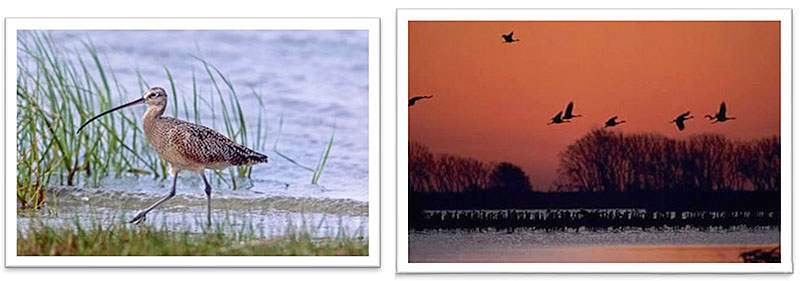 Cheyenne Bottoms/Quivira National Wildlife Refuge
Cheyenne Bottoms/Quivira National Wildlife Refuge
Barton & Stafford counties
Location: Cheyenne Bottoms is 6 miles north of Great Bend or from U.S. 281 and K-4 in Hoisington go 5 miles south and 2 miles east. Quivira National Wildlife Refuge visitor center is on 70th at the south end of the refuge; or, from Stafford, go 6 miles north of the railroad crossing on N. Main to a four-way stop, then 6 miles east to the Quivira Refuge sign, and 1 mile north. www.fws.gov/refuge/Quivira/ Refuge hours: daily, from 1-1/2 hours before sunrise to 1-1/2 hours after sunset. No camping or overnight stay is permitted. Visitor Center hours: Monday-Friday, 7:30 am to 4:00 pm Quivira is located 1 hour 30 minutes southwest of the Inn.
As a duo entry, the Kansas Wetlands Complex of Cheyenne Bottoms and Quivira National Wildlife Refuge are one of The 8 Wonders of Kansas because of their vital and international importance as a migratory stop for North American shorebirds! Cheyenne Bottoms is a 41,000-acre lowland basin and is the largest freshwater marsh in the interior of the United States. It is considered the most important shorebird migration point in the western hemisphere. Each year this area attracts 45 to 90% of the North American shorebird population during spring migration. At least 320 species of birds have been recorded. The area is a critical habitat for several threatened and endangered species such as Whooping Cranes, Peregrine Falcons, Least Terns, and Piping Plovers. Thousands of Sandhill Cranes stop here on their spring and fall migrations. Visitors can drive or walk along the dikes for some magnificent birdwatching. Less than 20 miles away, Quivira National Wildlife Refuge is 22,135 acres of prairie grass, saltwater marshes, sand dunes, canals, dikes, and timber. During spring migration, Quivira is a staging area for over 500,000 birds. Big and Little Salt Marshes are ancient basins that have attracted thousands of migratory waterfowl, providing them with food, cover, and a place to rest during exhausting flights between breeding and wintering areas. One good way to see both places is to drive the Wetlands and Wildlife National Scenic Byway. It curves around Cheyenne Bottoms and Quivira National Wildlife Refuge for 76 miles. A good beginning point is K-4 and U.S. 281 near Hoisington.
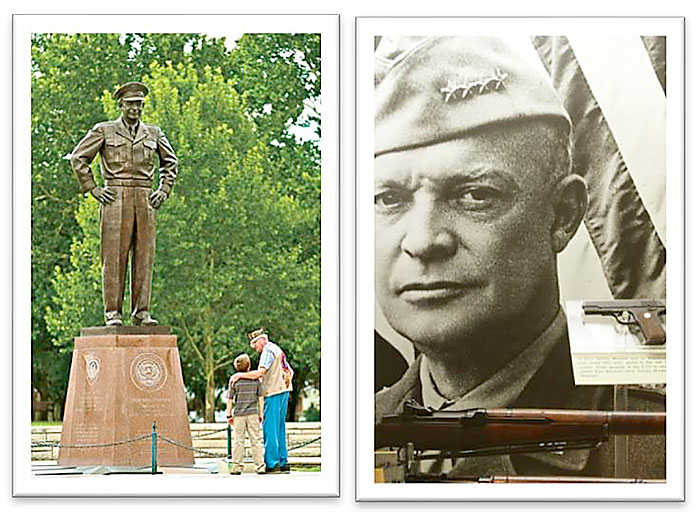 Dwight D. Eisenhower Presidential Library & Museum
Dwight D. Eisenhower Presidential Library & Museum
200 SE 4th Street, Abilene, KS 67410
(55 minutes northeast of the Inn)
785.263.6700
www.eisenhower.archives.gov/
All buildings at the Center are open daily from 9 a.m. until 4:45 p.m. but are closed Thanksgiving, Christmas, and New Year’s Day.
Summer Hours – June & July: 8:00 a.m. – 5:45 p.m.
The Dwight D. Eisenhower Presidential Library and Museum is one of The 8 Wonders of Kansas because it tells of the remarkable lifetime achievements of Dwight D. Eisenhower, five-star General and President of the United States! Dwight D. Eisenhower commanded the greatest amphibious military operation in history, the 1944 Allied invasion of Nazi controlled Western Europe. His many military achievements are interpreted superbly in the galleries at the Eisenhower Museum. He is the only five-star General to become President of the United States. The displays interpret the highlights of his two terms (1953-1961). Significantly, his administration initiated the nation’s first civil rights legislation in ninety years. He also sent Army troops when nine black students were intimidated into leaving Little Rock Central High School in Arkansas. More than any other president, Eisenhower was responsible for the Interstate Highway System. He was also so highly skilled in public relations that he seized the opportunity to become the first “television president.” Five galleries at the Eisenhower Museum tell the story of Eisenhower from his childhood days in Abilene through his retirement years. One gallery represents the life and lifestyle of one of America’s most beloved First Ladies, Mamie Eisenhower. Visitors can also tour the nineteenth-century wood-frame house, located on its original site, where the Eisenhower’s lived from 1898 until the death of the President’s mother Ida in 1946. The Place of Meditation is the final resting place of the President, his wife Mamie, and their first-born son, Doud Dwight.
 Kansas Underground
Kansas Underground
Salt Museum
3504 E. Avenue G Hutchinson, KS 67501
(46 minutes south of Inn)
620.662.1425
underkansas.org
Hours and admission charge:
Check underkansas.org for ticket prices and times
The Kansas Underground Salt Museum is one of The 8 Wonders of Kansas because it showcases the natural treasure, salt, that exists hundreds of feet below the Kansas plains!
Hutchinson seized the unique opportunity to provide a destination attraction for the citizens of Kansas, the United States, and the world to explore an exotic environ carved from salt deposits formed 280 million years ago, 650 feet below the surface.
In the United States there are 16 salt mines, but Hutchinson is the only one, in fact the only one in the Western Hemisphere, that has an underground museum open to tourists. There are only two other underground salt museums in the world, and they are in Poland and Austria. People from throughout the country have clamored for an opportunity to visit the Hutchinson salt mine.
Now, Hutchinson and the Reno County Historical Society have boldly made these visits possible. The simple elegance of a descent into a subterranean world of mystery is a powerful lure for potential visitors. The dream of an underground tourist destination is now a reality.
The adventure at the Kansas Underground Salt Museum begins on board a double-decked elevator that takes visitors to the salt deposit 650 feet down. Upon arriving underground, they board a tram that takes them into mined out areas where they will see naturally occurring geologic formations and artifacts left behind by miners over a period of 85 years. They then have the opportunity to wander through exhibits that tell the story of salt mining, the geological history of the area and how these vast salt caverns under Hutchinson have been used to store over seven million documents.
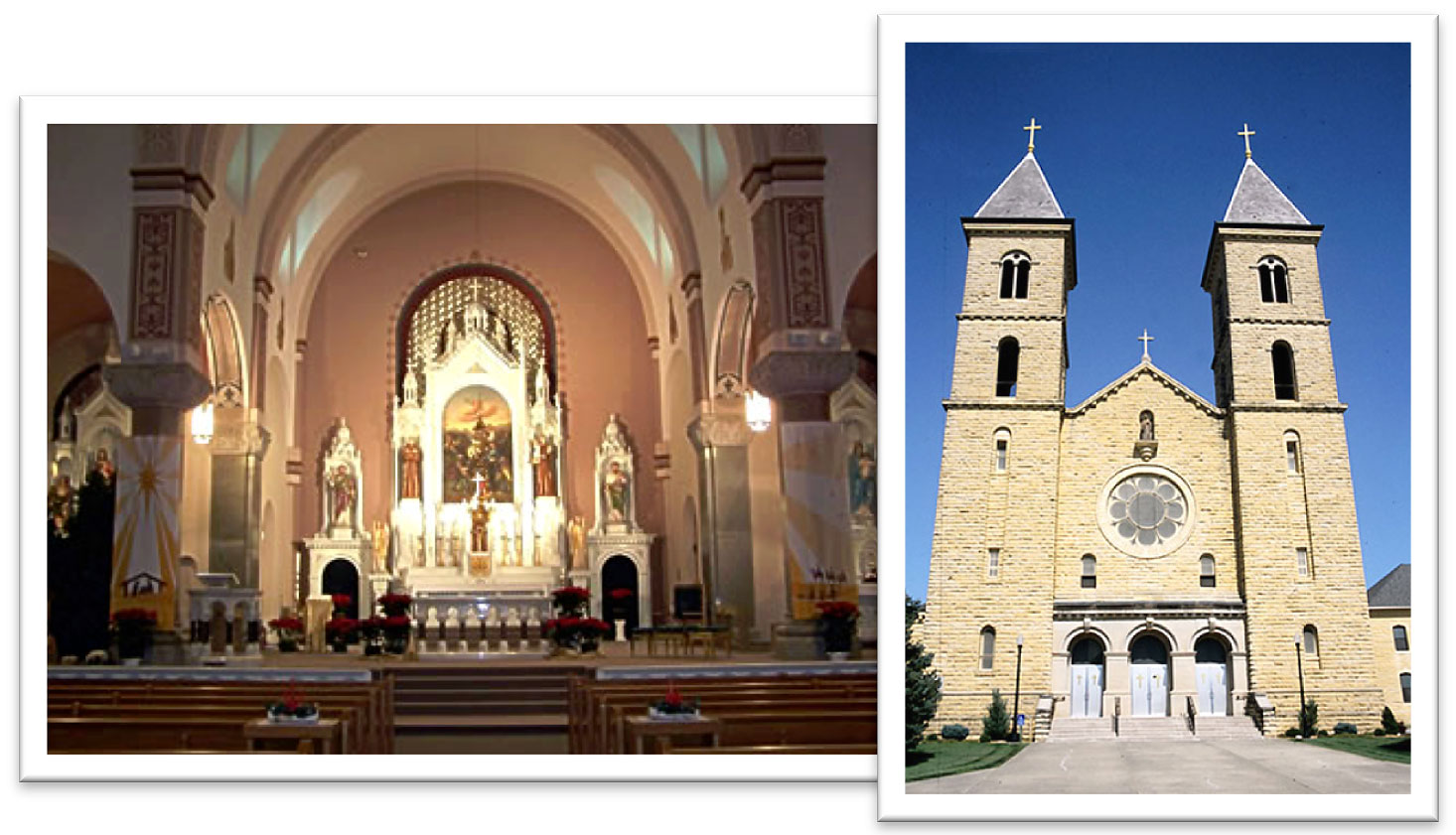 St. Fidelis Church
St. Fidelis Church
900 Cathedral, Victoria, KS 67671
(1 hour 3 minutes west of the Inn)
785.735.2777
www.stfidelischurch.com
Contact: fidelis@ruraltel.net
Hours: Open daily.
St. Fidelis Church is one of The 8 Wonders of Kansas because of the architectural grandeur and the impressive craftsmanship achieved by the Volga German pioneers!
If you’re anywhere near Victoria, you can’t miss the twin bell towers of St. Fidelis rising majestically above the plains. With a seating capacity of 1,100, St. Fidelis was the largest church west of the Mississippi when it was completed in 1911. Its beauty and size inspired William Jennings Bryan (visiting the area in 1912 on a presidential campaign) to dub it the “Cathedral of the Plains.”
The stone for this massive Romanesque structure came from a quarry seven miles south. The extracting of the stone, loading it, hauling it, and then dressing it was a gigantic task and an amazing feat considering that it was accomplished without automatic lifts and power tools.
The church structure is a cruciform or built in the shape of a cross 220 feet long and 110 feet wide at the transepts and 75 feet at the nave. The massive twin bell towers are 141 feet tall and dominate the prairie landscape.
The granite pillars that support the church were shipped in from Vermont.
The restoration of the church interior is also a tribute to the continued dedication of the people of the parish. A native son of the parish, Wayne Brungardt, was hired to be the architect of the restoration in the 1990s. Tim Linenberger, the third generation of Linenbergers (originally from Victoria) to have painted the church, painted the interior and did intricate stenciling returning the church to the original rich mauve and gold tones.
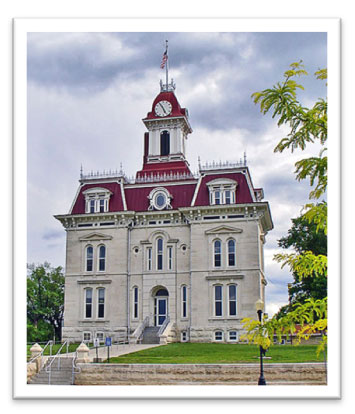 Chase County Courthouse
Chase County Courthouse
300 Pearl Street Cottonwood Falls, KS 66845
(1 hour 20 minutes east of the Inn)
620.273.8469
https://chasecountychamber.org/chase-county-courthouse/
Hours:
Self-Guided tours available weekdays 8am-5pm (except government holidays). Tour brochures are available in the foyer of the courthouse and at the Chase County Chamber Office located at 318 Broadway. Guided Group tours available (10+ people) by appointment, 12-4 pm. Monday – Friday and Saturdays (April – November) Call the Chase County Chamber to schedule a tour.
The Chase County Courthouse is a finalist for the 8 Wonders of Kansas because its striking French Renaissance (Second Empire) style and red mansard roof make it one of the most recognizable buildings in Kansas!
The Chase County Courthouse is the oldest courthouse in the Midwest still in daily use. Completed in 1873, the Courthouse is built from native limestone that was quarried and hand-cut in the Flint Hills. The limestone blocks were then brought to the Courthouse by horse-drawn wagons; some stones weighed nearly seven tons. Over 140 years later, the Courthouse is unmatched in durability and design, and remains a living tribute to its builders and the Flint Hills pioneers.
Highlights include a three-story black walnut spiral staircase, a working courtroom with embossed tin ceiling, jury room and judge’s chamber, and the unique solidly built jail with steel door.
Courthouse Fun Facts:
- Native limestone, used in the building, has been shipped to every state in the country where it may be found in scores of famous public structures, including the Capitol Building in Washington D.C. and the Topeka State House.
- The Register of Deed’s office contains an unusual vault, circa 1910, that is two stories high with a glass brick ceiling.
- The courthouse was placed on the National Historic Register in 1971 and greets over 6,000 visitors each year from every state and many countries.
- The original construction cost in 1873 was $40,000.
- Workers on the courthouse were paid well by the standards of the day. Stonemasons earned $3.50 per day, and other workers earned $1.75 to $2.25 a day.
- Above the jail is a walk-in attic containing a large wooden plank cistern used to collect rain water from the tile roof.
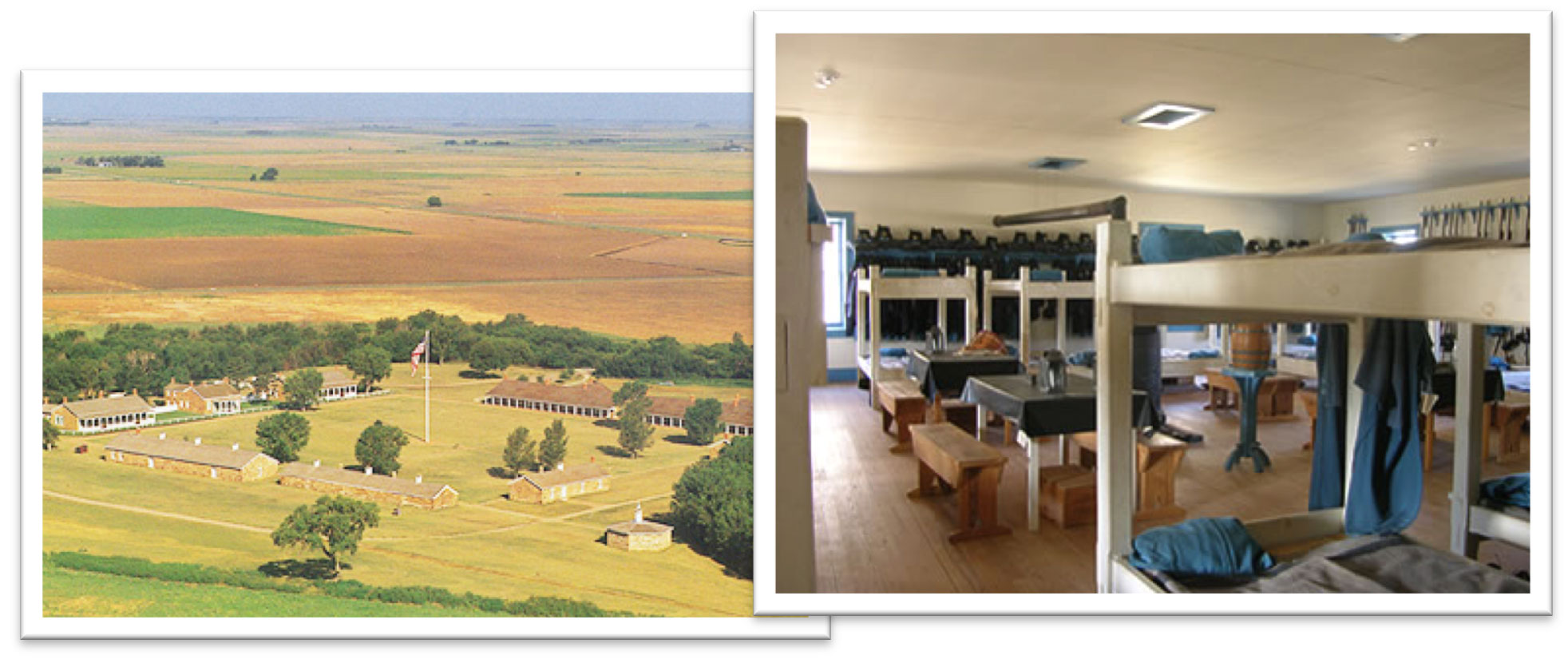 Fort Larned National Historic Site
Fort Larned National Historic Site
1767 K-156, Larned, KS 67550
(2 hours west of the Inn)
620.285.6911
www.nps.gov/fols
Hours:
Daily 8:30 a.m.-5 p.m.
Contact: Kevin_mcmurry@nps.gov
Fort Larned National Historic Site is a finalist for the 8 Wonders of Kansas because it is the best-preserved authentic frontier post in the American West.
After the construction of native-stone buildings in 1867-1868, under direction of Captain A. F. Rockwell, Fort Larned was a premier post on the Great Plains. Rockwell’s work is legendary, attested by the fact that all buildings constructed at Fort Larned still stand today. Following its active years, the sturdy structures of the post were preserved and used by private owners. The National Park Service acquired the site in 1964. Today Fort Larned National Historic Site has nine original stone structures (including post hospital, bakery, blacksmith shop, enlisted men’s barracks, mess hall, officers’ quarters, and storehouses) and a reconstructed blockhouse. It is situated in a pristine setting on the Pawnee tributary of the Arkansas River.
Fort Larned was established in 1859 and was designed to keep the peace on the plains and did so remarkably well through the era of the Civil War and the Plains Indian Wars. Located in an area frequented by many Plains Indians, including Pawnee, Cheyenne, Arapaho, Kiowa, Comanche, and Sioux, military personnel and Indian agents stationed here faced many challenges. The post served as a distribution point for tribal annuities for a few years, leading to an unusual twist of circumstances: the fort that was established to keep Indians from the Santa Fe Trail became a gathering place where large numbers of Indians came to collect their annuities.
Many famous officers walked the grounds at Larned as they were passing through including Winfield S. Hancock, George A. Custer, Kit Carson, and Philip Sheridan.
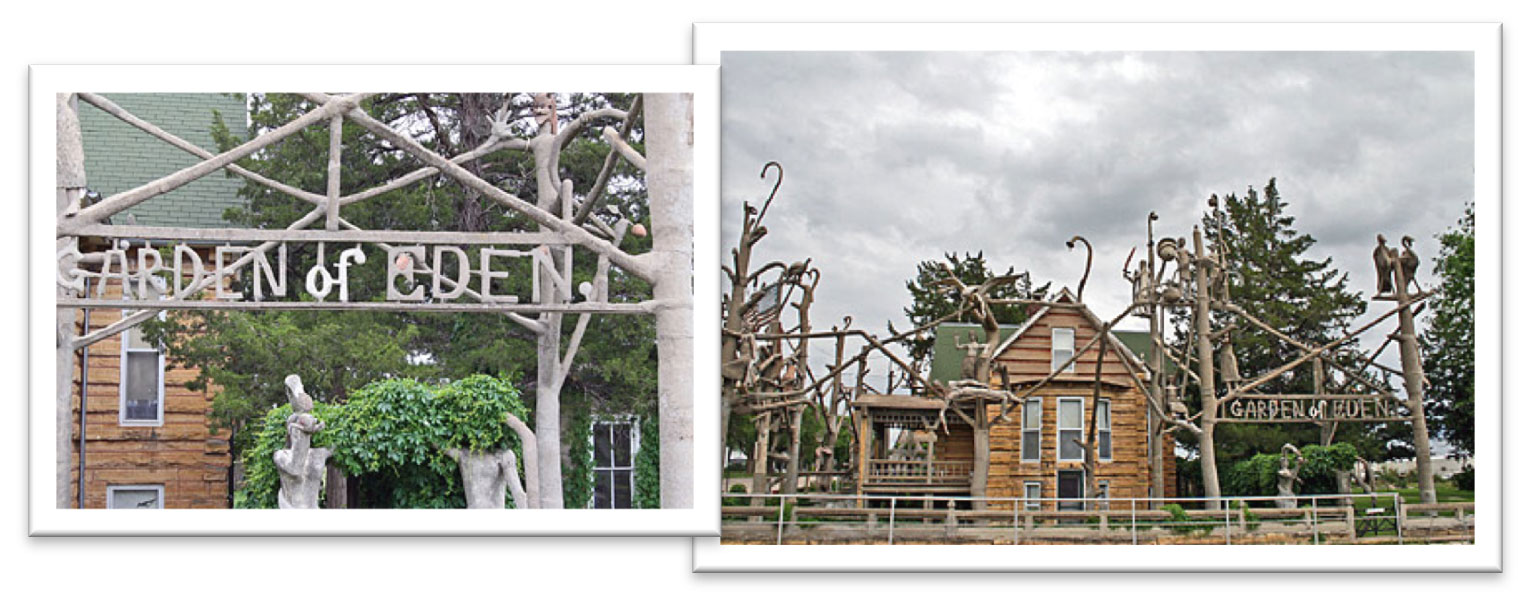 Garden of Eden
Garden of Eden
305 E. 2nd, Lucas, KS 67648
(1 hour 20 minutes northwest of the Inn)
785.525.6395
www.gardenofedenlucas.org
Hours and admission charge:
May-October, daily 10 a.m.-5 p.m.;
November-February, Saturday-Sunday 1-4 p.m.
Adults $6; children 6-12 $1.
The Garden of Eden is a finalist for the 8 Wonders of Kansas because it is a world-renowned grassroots art site with one of the most fascinating (and bizarre) sculpture gardens in the world!
In 1907, at the age of 62, Civil War veteran Samuel Perry Dinsmoor began construction of this unusual site by building a structure of limestone logs, (some up to 21 feet long) for the family home. Then, using 113 tons of cement, Dinsmoor built 40-foot tall trees to hold his larger than life figures for his sculpture garden. He stopped working on the sculpture in 1929 because he went blind!
Tour guides help an observer become fully aware that every part of every cryptic sculpture has meaning about Populist politics, modern civilization, and the Bible that connect like a dot-to-dot puzzle. The humor and message that he conveys through the sculptures amazes visitors.
Dinsmoor also built a mausoleum to house his mummified remains! Always a jokester, he claimed he would wink at anyone who paid to tour the garden. His vision was accurate and today the Garden of Eden supports itself through admissions. While Dinsmoor was building and creating locals tried to run him out of town. Decades later, the Garden of Eden became the town’s main attraction and today Lucas is known as the Grassroots Art Capital of Kansas.
Visitors to Lucas should take time to visit other grassroots art attractions in town to understand the extent of the legacy left by one of Kansas’ most eccentric artists. Start at the downtown Grassroots Arts Center that showcases other grassroots artists. Also find Eric Abraham’s Ceramic Flying Pig Studio, Erika Nelson’s World’s Largest Souvenir Travel Plate, Florence Deebles Sculpture Rock Garden and Mri Pillar’s 3D art of recycled products.
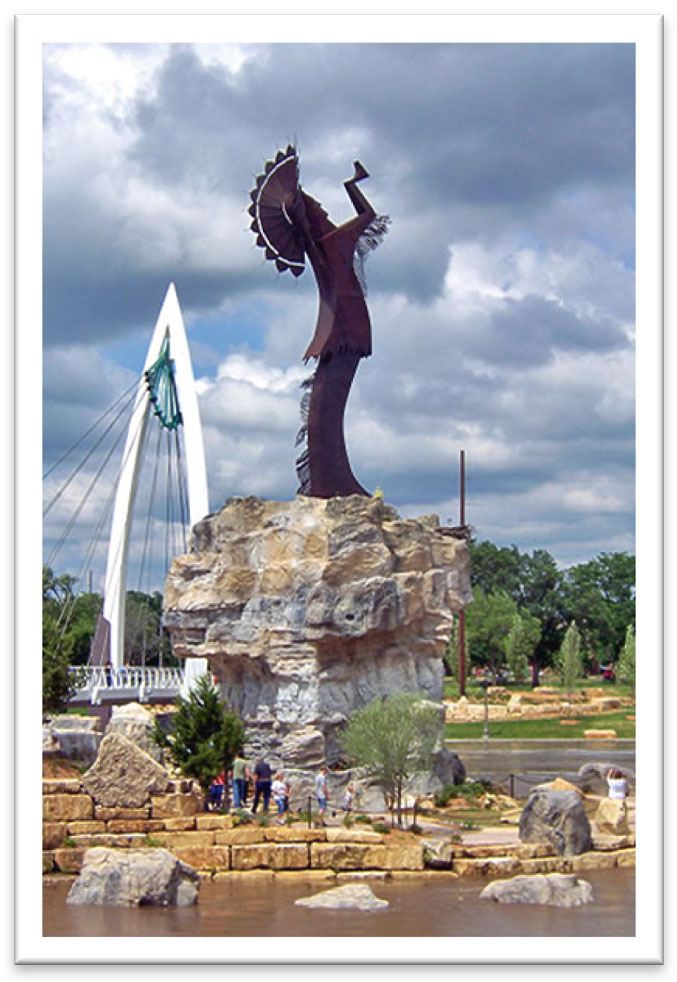 Keeper of the Plains
Keeper of the Plains
650 N. Seneca, Wichita, KS 67203
(1 hour 10 minutes south of the Inn)
316.262.5221
https://www.360wichita.com/Attractions/KeeperofthePlains.html
Contact: maaic@sbcglobal.net
Hours and admission charge: N/A
RING OF FIRE HOURS:
The Keeper of the Plains “Ring of Fire” will burn the following schedule during the months of Daylight Savings Time:
Friday-Saturday nights: 9, 10 and 11 p.m. for 15 minutes.
Sunday-Thursday nights: 9 and 10 p.m. for 15 minutes.
Once Daylight Savings Time is over, typically in late October, the burn hours will be:
Friday-Saturday nights: 7 and 8 p.m. for 15 minutes. Sunday-Thursday nights: 7 p.m. for 15 minutes.
The Keeper of the Plains is a finalist for the 8 Wonders of Kansas because it is an awe-inspiring sculpture by well-known artist Blackbear Bosin that honors the region’s original citizens and has become a symbol of Wichita!
On May 18, 1974 a ceremony took place to dedicate the Keeper of the Plains as a Wichita Bicentennial project. The majestic 44-foot sculpture was designed by Blackbear Bosin (1921-1980), a Kiowa-Comanche and internationally-recognized artist, muralist and designer.
It was Bosin’s gift to the city. The five-ton sculpture was placed at the confluence of the little and big Arkansas Rivers which is considered a sacred site by Native Americans and was home to the Wichita tribe for many years.
The 5-ton Keeper has recently undergone a renovation and now rests atop a new 30-foot pedestal facing east. The Keeper Plaza incorporates the history of the Native Americans and embodies a “sacred hoop” and the four elements that make up life (earth, air, fire and water).